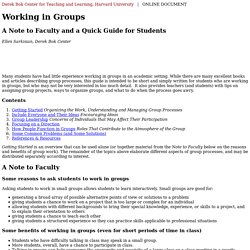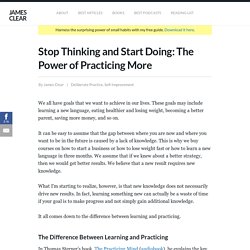

Working in Groups - Harvard University. Derek Bok Center for Teaching and Learning, Harvard University | ONLINE DOCUMENT A Note to Faculty and a Quick Guide for Students Ellen Sarkisian, Derek Bok Center Many students have had little experience working in groups in an academic setting.

While there are many excellent books and articles describing group processes, this guide is intended to be short and simply written for students who are working in groups, but who may not be very interested in too much detail. It also provides teachers (and students) with tips on assigning group projects, ways to organize groups, and what to do when the process goes awry.
Contents Getting Started is an overview that can be used alone (or together material from the Note to Faculty below on the reasons and benefits of group work). A Note to Faculty Some reasons to ask students to work in groups Asking students to work in small groups allows students to learn interactively. Some benefits of working in groups (even for short periods of time in class) The Practicing Mind - Thomas M. Sterner. Scrum - The Art of Doing Twice the Work in Half the Time - Jeff Sutherland. "This book cuts through the jargon and pedagogy and gets to the essence of what makes it work.

" -–Adam Messinger, CTO, Twitter "Jeff Sutherland succeeds brilliantly. " --Eric Ries, New York Times bestselling author of The Lean Startup "Senior leaders should not just read the book—they should do what Sutherland recommends. " -–Jeffrey Pfeffer, Professor, Stanford Graduate School of Business, co-author of The Knowing-Doing Gap amazon|b&n|iTunes|indiebound Editorial Reviews for Scrum The Art of Doing Twice The Work In Half the Time: As Sutherland explains, this process requires “thought, introspection, honesty, and discipline.” ... --Publishers Weekly The beauty of Scrum is that its principles and strategies can be applied in whole or in part to organize, plan and carry out any project, from implementing a new software program to planning an event or scaling up a young enterprise.
--Success Magazine --Booklist "This book contains immense practical value that could be transformative for your company. Stop Thinking and Start Doing: The Power of Practicing More. We all have goals that we want to achieve in our lives.

These goals may include learning a new language, eating healthier and losing weight, becoming a better parent, saving more money, and so on. It can be easy to assume that the gap between where you are now and where you want to be in the future is caused by a lack of knowledge. This is why we buy courses on how to start a business or how to lose weight fast or how to learn a new language in three months.
We assume that if we knew about a better strategy, then we would get better results. We believe that a new result requires new knowledge. What I’m starting to realize, however, is that new knowledge does not necessarily drive new results. It all comes down to the difference between learning and practicing. The Difference Between Learning and Practicing In Thomas Sterner’s book, The Practicing Mind (audiobook), he explains the key difference between practicing and learning.
Let’s say your goal is to get stronger and more fit. 1. 2. 3. Post-its Plus App. Ideas don’t stop when the meeting ends The Post-it® Plus App takes the momentum from your collaboration sessions and keeps it rolling.

Simply capture your notes, organize and then share with everyone. It’s that easy. How does it work? The Post-it® Plus App makes it easy to keep your team moving forward following any collaboration session: Capture your notes Use the app to capture the Post-it® Notes from your work session. Organize your thoughts Arrange, refine and organize the notes on your board — any way you see fit. Share with everyone Share your organized board with your team. Post-it® Plus App Features Discover the benefits that help make the Post-it® Plus App the centerpiece of your workflow: Capture multiple notes.
The workspace for your life’s work. Trello. Subscribe to Basecamp today.